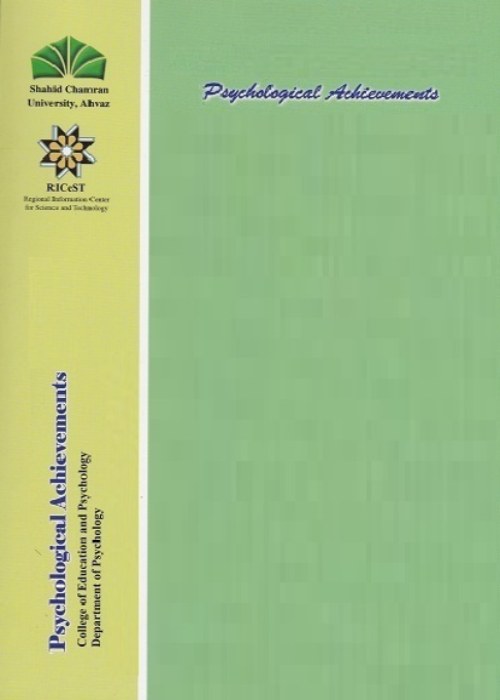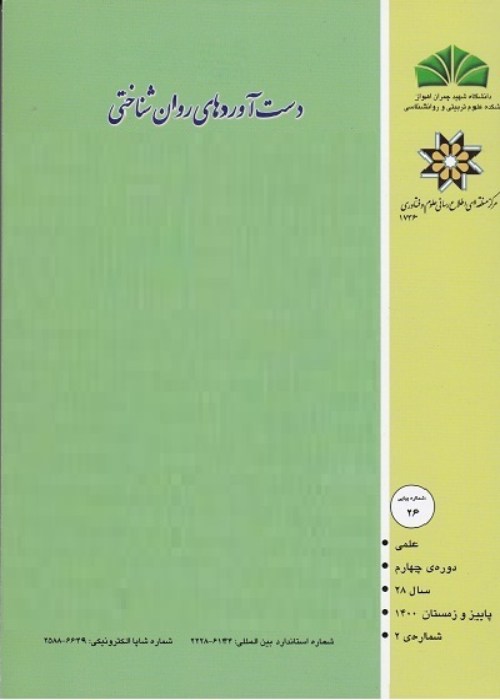فهرست مطالب

مجله دستاورد های روانشناختی
سال بیست و نهم شماره 2 (پیاپی 28، Autumn- Winter 2022)
- تاریخ انتشار: 1402/01/05
- تعداد عناوین: 7
-
-
Pages 1-14AimThe aim of this study was to examine the effectiveness of schema therapy in experiential avoidance and anxiety sensitivity of students with academic procrastination at Ahvaz Jundishapur University of Medical Sciences.MethodsIt was a quasi-experimental study with a pretest-posttest design with a control group. The statistical population included students with academic procrastination studying at Ahvaz Jundishapur University of Medical Sciences in the academic year 2021-2022. The first sample of the research consisted of 500 students who were selected by the multi-stage cluster sampling method. These people answered the academic procrastination questionnaire of Solomon and Roth Bloom (1984), and 152 of them who got at least one score higher than the standard deviation score were separated from Among them, 42 people who met the criteria for entering the research were selected and placed in two groups of 21 people (experimental and control group). The experimental group received schema therapy; however, the control group did not receive any intervention. Other tools of this research include. Reiss et al. (1986) Anxiety Sensitivity questionnaire, and Gamez et al.’s (1988) Multidimensional Experiential Avoidance questionnaire. the research hypotheses were tested through multivariate analysis of covariance (MANCOVA) through SPSS software (version 25).ResultsThe results showed that there was a significant difference between the experimental and the control groups in the post-test phase in terms of experiential avoidance (p <0.0001, F = 42.81) and anxiety sensitivity (p <0.037, F = 4.67). This difference was also observed in the follow-up phase.ConclusionTherefore, according to the findings of this study, schema therapy can be used to reduce experiential avoidance and the anxiety sensitivity of students with academic procrastination.Keywords: Schema Therapy, Experiential Avoidance, anxiety sensitivity, academic procrastination
-
Pages 15-26AimThis study aimed to investigate the role of cognitive emotion regulation strategies and behavioral activator-inhibitor systems in depression.MethodsThe research method was descriptive correlational with 240 female undergraduate and graduate students of Shahrekord University (Western province of Iran) selected through a random sampling method. They answered Beck Depression Inventory, Granovsky’s Cognitive Emotion Regulation Questionnaire, and Carver and White’s Brain Systems Scale. The data were analyzed using SPSS 22.ResultsThe mean and standard deviation of each variable were calculated as descriptive statistics, and Pearson correlation was employed to evaluate the relationships of variables. The results showed a significant negative correlation between behavioral activator systems and depression, and a significant positive correlation between behavioral inhibitor systems and depression. In general, the behavioral activator-inhibitor systems predicted 33% of depression variance. In addition, there was a significant positive relationship between maladaptive strategies of cognitive emotion regulation and depression and a significant negative relationship between adaptive strategies of cognitive emotion regulation and depression.ConclusionThe results showed that among the maladaptive strategies of cognitive emotion regulation, the catastrophic component predicted about 29% of depression variance, and among the adaptive strategies of cognitive emotion regulation, the acceptance component predicted about 39% of depression variance. In general, the results of this study indicated that brain-behavioral systems and emotional cognitive regulation strategies had chief roles in predicting depression. Relying on the findings of this study, we can present a practical framework to explain the symptoms of depression and its treatment.Keywords: Behavioral Activator System (BAS), Behavioral Inhibitor System (BIS), Emotion Cognitive Regulation, Depression
-
Pages 27-36AimThe present study was conducted to compare the symptoms of anxiety disorders, emotional literacy, and emotion expression in deaf, HH, and hearing students in four cities in Iran.MethodsThis causal-comparative study was conducted with the participation of deaf, Hard-of-Hearing (HH), and hearing students in Iran in 2019. A total of 72 (38 HH and 34 deaf) students with HL and 72 hearing students participated in the present research. The Screen for Child Anxiety-Related Emotional Disorders, The Emotional Literacy Assessment Instrument, and The Emotion Expression Scale for Children were used for data collection. The data were analyzed using MANOVA.ResultsThe results showed a higher rate of anxiety disorders in deaf and HH students than in hearing students. Emotional literacy was lower in deaf and HH students than in the hearing students, and it was lower in deaf students than in the HH students. Also, disturbance in emotional expression (Poor Awareness Factor [PAF] and Expressive Reluctance Factor [ERF]) was higher in deaf and HH students than in hearing students, and PAF was lower in deaf students than in HH students.ConclusionThe results support the existence of anxiety symptoms, low emotional literacy, and difficulties in expressing emotions in students with HL.Appropriate psychological and pedagogical strategies to reduce anxiety disorders and increase the level of emotion expression and emotional literacy in students with HL are recommendedKeywords: Anxiety, Emotion Expression, Emotional Literacy, Hearing Loss
-
Pages 37-48BackgroundChallenges in the field of education show their deconstructive presence and have a dramatic and sometimes negative impact on students' psyche, ethics and behavior. The impact of methods, practices and changes, the education system faces many challenges in various fields such as educational-ethical challenges.ObjectivesThe present study examines students' experiences of facing the educational-ethical challenges of depression and suicide.MethodsThe research method is qualitative and has been done using phenomenological method. The statistical population of this study includes all female high school students in Ahvaz. After identifying the educational-ethical challenges, 20 students were purposefully selected for the interview according to the available samples in the field of depression challenges and suicide (suicide attempt). In the field of saturation depression challenge after 12 people and in the suicide challenge (suicide attempt) after 13 people saturation. Identification of educational-ethical challenges is in accordance with the reports sent by Ahvaz District 2 school counselors to the counseling core of that district. The three-step recour method was used to analyze the interview data. The steps include raw reading or simple comprehension, structural analysis, and total interpretation.ResultsIncludes 5 main themes of causes of depression, methods of coping with depression, main causes of suicide, pretending to attempt suicide, students' feelings about suicide and 14 sub-themes.ConclusionStudents face many educational-ethical challenges. Challenges that are not rooted in their subconscious thoughts, but are rooted in untested assumptions and misconceptions.Keywords: Challenge, Education, ethics, Phenomenology
-
Pages 49-64AimGiven the importance of employee innovation in the performance of advertising organizations, this study seeks to examine the effect of social support (family and work) on women's innovative work behavior with the mediating role of work-family conflict. The answer to the question can help to a better understanding of this issue.MethodsThis study was a descriptive/survey in terms of the data collection method and applied in terms of purpose. A questionnaire containing 53 questions was designed by the standard measures of previous studies and randomly distributed among 568 female employees in advertising companies in the two metropolises of Iran to collect data. Then, the structural equation model and the software of Amos software, and SPSS were used to analyze the data and test the assumptions of the relationship between the conceptual model.ResultsThe hypothesis test showed that work-family conflict mediates the relationship between social support (family and work) and repetitive thought. The role of moderating epetitive thought in the relationship between work-family conflict and innovative work behavior was also demonstrated. Besides, the research findings indicate the negative impact of social support (family and work) on work-family conflict.ConclusionInnovative work behavior has been studied in various research due to its importance. However, the present study, for the first time, shows how social support can affect innovative work behavior through work-family conflict and repetitive thoughtKeywords: advertising companies, family social support, innovative work behavior, work-family conflict, work social support
-
Pages 65-78BackgroundProcrastination or voluntary delay in doing an important and necessary activity, despite the expected negative consequences that outnumber the positive consequences of delay, is a common phenomenon in the modern society. On the basis of various data, procrastination affects 20 to 95 percent of adults in western countries and studying this phenomenon is very important.ObjectivesThe purpose of this study was to investigate the psychometric properties and the factor structure of temporal focus scale and to study the mediating role of temporal focus in the relationship between procrastination and impulsivity- delay discounting.MethodsFour hundred people (279 females and 121 males) were selected through convenience sampling from universities of Kermanshah (west of Iran). They were evaluated by questionnaires of impulsivity, monetary-choice, pure procrastination, and temporal focus. Data were analyzed based on Cronbach's alpha test, intra-class and Pearson correlation tests, exploratory factor analysis, and structural equation modeling using SPSS and Mplus software.ResultsThe results showed that the reliability of the temporal focus scale was appropriate using all three measures of internal consistency (Cronbach's alpha = 0.91), split-half reliability (Guttman split-half coefficient = 0.90), and test-retest reliability (intra-class correlation = 0.78). Exploratory factor analysis led to the expected three-factor structure. The proposed model fitted well with the data. Temporal focus, urgency, and delay discounting had direct effects, and urgency and lack of perseverance had indirect effects (due to temporal focus) on procrastination.ConclusionThe Persian version of the temporal focus scale has acceptable validity and reliability, and given the little time it takes to be filled out, it can be a proper tool to be used in various situations. Temporal focus, especially focusing on the past, plays a unique role in negligence, and a closer examination of this variable may help to better understand the underlying mechanisms of procrastination.Keywords: Delay discounting, impulsivity, procrastination, temporal focus
-
Pages 79-94Aim
Considering the effects of hidden communication aggression and its consequences on the couple's relations, reducing it can diminish its consequences. The present study aimed to examine the model of direct and indirect effects of self-esteem and communication skills on sexual satisfaction with mediating role of hidden aggression dimensions of spouses in female nurses of public and private hospitals in Shiraz city.
MethodsThe study sample consisted of 310 female nurses selected through the two-stage random cluster sampling method. The research method was correlational, and the research tools were the Self-Esteem Scale (SES), the Marital Social-Skills Inventory (MSSI), the Hidden Communication Aggression Scale (HCAS), and the Sexual Satisfaction Scale for Women (SSSW). Data analysis was done using Pearson's correlation coefficient and structural equation modeling.
ResultsThe results showed that there was a significant relationship in the direct paths of self-esteem to the social image sabotage, self-esteem to emotional withdrawal, communication skills to emotional withdrawal, self-esteem to sexual satisfaction, communication skills to sexual satisfaction, social image sabotage to sexual satisfaction, and emotional withdrawal to sexual satisfaction, but the relation of communication skills to the social image sabotage was not significant (P=0.41). Also, the mediating role of emotional withdrawal was significant between self-esteem and sexual satisfaction (P=0.006, b=0.038) and between communication skills and sexual satisfaction (P=0.006, b=-0.062) at P<0.05. But the mediating role of the social image sabotage variable was not significant between communication skills and sexual satisfaction (P=0.20, b=0.027) and between self-esteem and sexual satisfaction (p=0.06, b=-0.034).
ConclusionResearchers interested in this field are suggested to examine the effect of home violence and especially covert violence in other psychological variables so that the results of this type of violence in married life can be better recognized. The results of this research on self-esteem showed that people with high self-esteem have higher quality and satisfaction in their relationships and married life. Thus, those responsible for the education and upbringing of people since childhood (family, teachers, counselors, etc.) should attempt to increase this spirit in people and make the increase of this spirit in the individual a priority of their work
Keywords: Social image sabotage, Emotional withdrawal, Sexual satisfaction, Self-esteem, Communication skills


